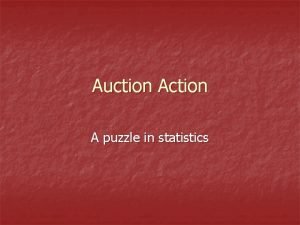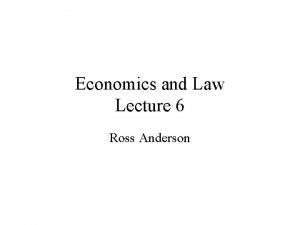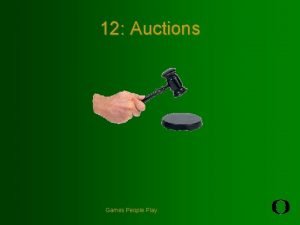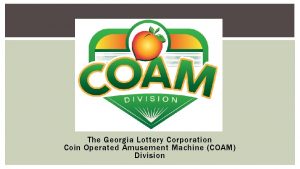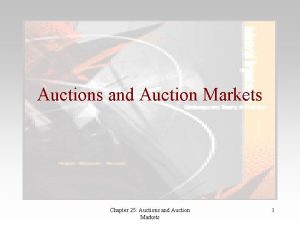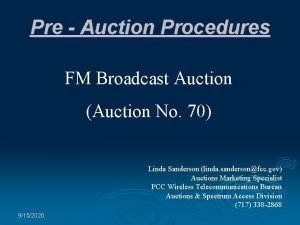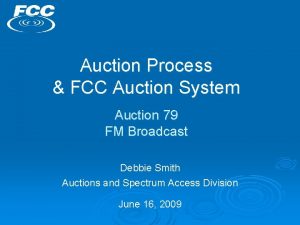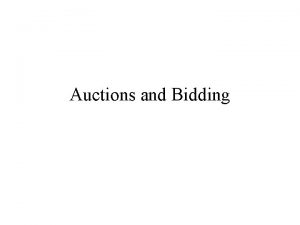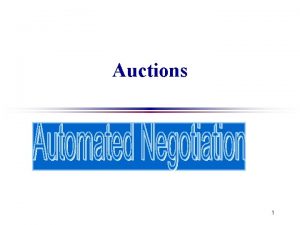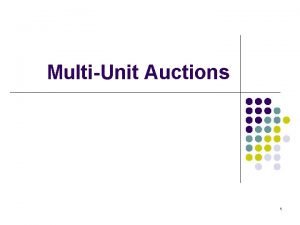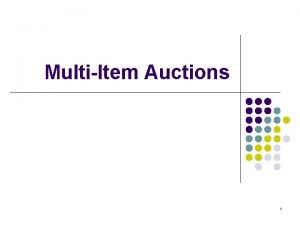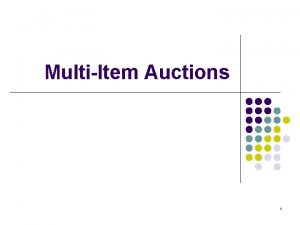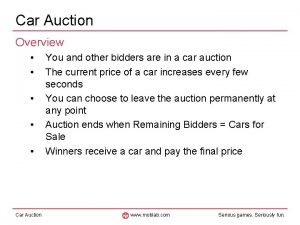Auctions and Auction Markets Chapter 25 Auctions and


















- Slides: 18

Auctions and Auction Markets Chapter 25: Auctions and Auction Markets 1

Introduction • Auctions have an old history and are increasingly common – 193 AD, Praetorian Guard auctioned off the Roman Empire to Marcus Didius Salvius Julianus – Modern Examples • e. Bay (Consumers) • Covisint/Free Markets (B 2 B) • Wireless Spectrum Auction (Government 2 B) Chapter 25: Auctions and Auction Markets 2

Auction Types • Ascending Bid or English Auction – Probably most familiar—Price starts low – Price is raised gradually until only one bidder remain • Descending Bid or Dutch – Price starts high – Price is lowered until someone finally wants to buy • Sealed Bid Auctions – Bids effectively submitted in sealed envelopes § First-Price Sealed Bid: Winning bidder pays amount bid § Second-Price Sealed Bid: Winning bidder pays amount equal to second-highest bid Chapter 25: Auctions and Auction Markets 3

Auction Types 2 • Private Value Auction—Item value different for each bidder • Common Value Auction—Item value common to all bidders but each has different information about true common value • Almost Common Value—Item has a common value to most players but some put a noticeably higher value on it Chapter 25: Auctions and Auction Markets 4

The Revenue Equivalence Theorem Revenue to Seller is Same Regardless of Auction Type in a Private Value Auction • Consider auction of textbook among 170 students • Values start at $0. 50 and increase by $0. 50 with each student. So, top value is $85 • Consider English Auction where Auctioneer raises price by 1¢ each round – When bid reaches $84. 50, only two bidders remain – Winning bid will be $84. 51 when only one bidder is left Chapter 25: Auctions and Auction Markets 5

Revenue Equivalence 2 • Now Consider Second Price Sealed Bid – If bidders bid their true values, top two bidders will bid $85 and $84. 50, respectively – Bidder with $85 valuation will win but pays only $84. 50 $84. 51 • Why bid one’s true value in 2 nd-price, sealed bid auction? – What one bids determines only if one wins—not what one pays • Bidding less than true value risks losing the object to someone who values it less than one is willing to pay without changing the price • Bidding more than true value raises chance of winning but only by beating a bidder with a higher value than your own • You will then pay that higher value and, since it exceeds your own, lose out Winning bid the same in English and 2 nd price sealed bid cases Chapter 25: Auctions and Auction Markets 6

Revenue Equivalence 3 • Now Consider First-Price, sealed bid auction – bidders observe no other information about other bidder’s value prior to making a bid – Winner pays the winning bid – Suggested Strategy: Bid an amount equal to one’s best guess of next highest bid • Treat your value as the highest (if it’s not, winning is too costly) • If valuations are uniform, next highest is (N – 1)/N of your value • E. g. , bidder with value $85, bids (N – 1)/N *$85 = $84. 50, N = 170 – Here again, winning bid is $84. 50 out Chapter 25: Auctions and Auction Markets 7

Revenue Equivalence 4 • Finally, consider the Dutch or descending price auction • This is strategically identical to first-price, sealed bid auction. Again, in both: – bidders observe no other information about other bidder’s value prior to making a bid – Winner pays the winning bid – Optimal strategy is the same in both So, winning bid is again $84. 50 Revenue Equivalence: Regardless of auction type, the winning bid or payment is always $84. 50 This is a quite general result. In private value auctions, the revenue to the seller is the same regardless of what type of auction is held It is good that Revenue Equivalence holds. We do not want an object’s price to depend on how it is bought Chapter 25: Auctions and Auction Markets 8

Common Value Auctions In common value auctions, item has an unknown but common market value, e. g. , real estate • Bidders have different information about the true value • That true value depends on what others are willing to pay • Revenue Equivalence may not hold The “Winner’s Curse” in Common Value Auctions • Winner of a common value auction is one with highest estimate of true common value, e. g. , highest estimate of the value of a property • Winning can be bad news. It reveals that the winner’s information was most upward biased and bid was higher than the average or expectation of the true value Chapter 25: Auctions and Auction Markets 9

Common Value Auctions 2 • Minimizing the Winner’s Curse – To avoid the winner’s curse, bidders need to shade their bids below that indicated by their information – This requires recognizing that one is interested in the object’s true value if one wins the bid, i. e. , if one wins, that says something about the object’s true value – Need somehow to use this information to estimate the average or expected mean value of the property Chapter 25: Auctions and Auction Markets 10

Common Value Auctions 3 • For example – Assume that your estimate E is the highest (you’re not interested in the object’s value if it is not) – If there are N bidders and the distribution is uniform, then highest value of E is on average, U(N-1)/N where U is the upper limit of the distribution. – Solving for U yields: U = [N/(N-1)]E Average Estimate is [N/2(N-1)]E. This is a good amount to bid. – It reflects the mean or expected value all the information draws conditional on yours being the most optimistic – Note: It is well below your E which is why it helps one minimize the winner’s curse. Chapter 25: Auctions and Auction Markets 11

Common Value Auctions 4 • Numerical example – Let there be 100 bidders each drawing estimates of a property’s value such that those estimates are uniformly distributed; and if my estimate is $10, 000 • My best guess is that the uniform distribution ranges from 0 to [100/(100 -1)]$10, 000 or from 0 to $10, 101 • My guess for the average value of the estimates is therefore $5, 050. 50 • I bid much less than the estimated property value in an effort to avoid the winner’s curse of paying too much Chapter 25: Auctions and Auction Markets 12

Common Value Auctions 5 • With Common Value auctions, all auction types may not generate the same revenue— • Ascending price auctions, for example, reveal more information than other types about the estimates of other bidders—Revenue Equivalence can break down • With Risk-Neutral bidders, conventional ranking (top to bottom) of auction revenue is: English Auction Second Price First Price Dutch Auction • This ranking changes if bidders are risk-averse Chapter 25: Auctions and Auction Markets 13

Almost Common Value Auctions • Some auctions are a mix of private and common valuations – “Almost common value auctions” are those in which the object has a common value to nearly all bidders but one who values the object by some amount, v, above everyone else – Surprisingly, even when v is small, the effect on revenue can be large. Why? Because the winner’s curse cuts doubly in this setting Chapter 25: Auctions and Auction Markets 14

Almost Common Value Auctions 2 • Example: 5 local coffee shops and Starbuck’s all bid for a coffee store – Assume that whatever the store is worth to the locals, it’s worth more to Starbuck’s – If so, each local bidder faces an intensified winner’s curse – To win the bid, it must beat Starbuck’s bid which is biased upwards – This means that its estimate must really be unusually high – Accordingly, local bidders shade their bids even more – But this allows Starbuck’s to be more aggressive, causing locals to shade their bids even more – Starbuck’s will win the bidding but at a much reduced price Chapter 25: Auctions and Auction Markets 15

Auction Markets and Industrial Organization • Consideration of aspects of common value and almost common value cases implies that auction design is important —Revenue Equivalence does not necessarily hold • This point is even more compelling when one considers lessons from industrial organization • Different revenue designs will have different revenue outcomes because they have different implications for the auction market regarding – Likelihood of entry and number of bidders in the auction; and – Ability of firms to communicate and collude Chapter 25: Auctions and Auction Markets 16

Auction Markets and Industrial Organization 2 • For example, an ascending/English auction does reveal information and therefore can limit the winner’s curse, which encourages bidding; BUT • The ascending auction also permit communication, which • Facilitates collusion • Facilitates communication of asymmetric values – On both counts, the English auction may result in lower revenue Chapter 25: Auctions and Auction Markets 17

Auction Markets and Industrial Organization 3 • In contrast, a sealed bid designs works well – It encourages entry because there is a chance of winning even if a firm’s estimated value is not the highest – It reduces collusion opportunities • If all auction designs have strengths and weaknesses, are there ways to build on strengths and avoid weaknesses? – – Reserve price—set minimum bid acceptable Hybyrid auctions, e. g. , Anglo/Dutch 1 st Round: bidding is English auction 2 nd Round: when down to just two bidders, switch to Sealedbid, second-price • Auction Design is an ideal place to put theory of Industrial Organization into Practice Chapter 25: Auctions and Auction Markets 18
 Susan mains artist
Susan mains artist Type of auctions
Type of auctions Baystate auctions
Baystate auctions Kista bus sales
Kista bus sales Dtting
Dtting Ecommerce online auctions
Ecommerce online auctions Ncdfi
Ncdfi Anderson auctions
Anderson auctions Play auctions
Play auctions Why study financial market
Why study financial market Characteristics of consumer behavior
Characteristics of consumer behavior Chapter 9 expanding markets and moving west
Chapter 9 expanding markets and moving west Buyer behaviour
Buyer behaviour Types of buyer behavior
Types of buyer behavior Chapter 5 consumer markets and buyer behavior
Chapter 5 consumer markets and buyer behavior Chapter 9 expanding markets and moving west
Chapter 9 expanding markets and moving west Chapter 9 expanding markets and moving west
Chapter 9 expanding markets and moving west Chapter 7 consumers producers and the efficiency of markets
Chapter 7 consumers producers and the efficiency of markets Coam master acct
Coam master acct


